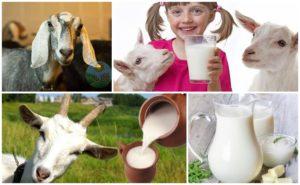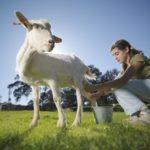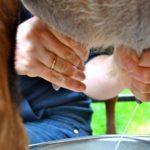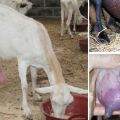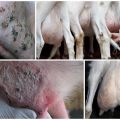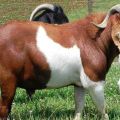How many times a day should a goat be milked after lambing and the rules for performing the procedure
The goat is a productive, unpretentious domestic animal, which both large farmers and owners of small subsidiary farms are willingly engaged in breeding. However, many people, especially beginners, often have questions about milking technique and timing. To increase milk yield and maintain the health of the goat, it is important to explain how many times after lambing and on what schedule it is recommended to milk the goat, what to do before and after lambing, how the milking procedure takes place.
When the goat starts giving its first milk
Goats are considered sexually mature at the age of 6-9 months. Fertilization should take place after reaching one and a half years. It is believed that by this age the goat is fully matured, ready to bear offspring. As soon as fertilization occurs, hormonal changes begin that cause milk to form in the udder.
No kids
First, colostrum is formed (a thick yellowish liquid), and only then does milk appear. It is secreted up to the moment when the kids begin to eat adult food. If the pregnancy is not the first, then the goats must be sent to the launch 1-1.5 months before lambing. This increases the daily amount of milk, its quality. Typically, the goat is fed food with a high protein concentration.
Experts recommend:
- the first milking of the goat should be done no later than 1.5-2 hours from the moment of the appearance of the offspring;
- before that, it is generally undesirable to milk it;
- the first week to milk 4 times a day, then switch to three times a day;
- take into account the time of the year: in the summer, the goat is milked three times a day, in the winter - twice.
There is a lot of controversy about the need to keep the mother without kids from the moment of birth. Some leave them together for breastfeeding until 2 months of age, others take them straight away, preferring early weaning. The choice is up to the owner.

Important! On average, goats produce milk for about six months, but in some dairy breeds, the lactation period lasts up to 11 months.
Udder preparation
For the goat, the milking procedure should become familiar and comfortable, and the milk yield should be as productive as possible. To do this, special attention should be paid to preparing the udder for lambing and milking - usually it begins a month before calving. Most often, a regular udder massage is dispensed with.
It is carried out as follows:
- gently rub one share of the udder with light hand movements;
- the lobe to be rubbed is raised, slightly squeezed with the palm, pressed against the upper part of the udder;
- return the share to its original position;
- repeat the procedure with each lobe 4-5 times.
To increase the amount of milk, the goat is first distributed, each time massaging the udder with your hands for 1-3 minutes. This is done on a schedule every 4-5 hours. Then the number of milkings is reduced to 1-2 times per day. So the animal becomes obedient, calms down, gets used to the hands of the breeder, and massage will have a beneficial effect on the body's blood circulation and productivity. Thanks to this technique, goat milk yield reaches its peak in a couple of months.
It is also recommended to teach animals to wash the udder, since not all of them are good at this simple rule of hygiene. However, this is necessary, therefore, it is advisable to teach to wash before giving birth. Usually, warm water is used for washing, then the udders are dried with a sterile cloth. Paper towels can be used. If the animal is often outdoors, then it is also worth washing the udder every week with baby or laundry soap.
Some farmers simply wipe their udders with germicidal wet wipes, which is also acceptable. It is important that they are odorless or free of additives. It is recommended that you cut your nails off before milking or washing.
Rules for milking a goat after lambing
Milking after childbirth should be done regularly. Nature has laid down that the kids first drink milk completely, but the goat needs to be milked additionally, even if it continues to feed the offspring. This facilitates the future milking procedure and also frees the udder from milk residues.

From the moment of birth, the kids are placed separately so that with their horns they do not injure the irritated udder of the mother, do not learn to constantly be with her.
Manual technique
Before manual milking, the goat is fixed, although this is not required if it is already accustomed to its owner and behaves calmly. It is believed that a familiar voice for an animal acts as a calming factor, guarantees safety, which makes it stop resisting or kicking. Therefore, when milking, it will not be superfluous to chat with the goat.
How to do hand milking:
- After giving birth, the first few streams of colostrum are donated into a separate cup due to the danger of pathogenic microorganisms and dirt.
- It is not recommended to donate to the ground or the floor, otherwise, even with regular cleaning, a specific aroma will appear over time.
- The milking process should not be interrupted or the pace should be changed. You need to do it quickly, at the same speed, rhythmically. This will be more convenient for the farmer and more comfortable for the animal.
- Usually, the first few days, milk is given to kids, even if they were taken away from their mother.
At the end of the process, it is necessary to wipe the mammary glands from the remains of milk, also massage a little with your hands, it is advisable to lubricate with a special cream, for example, baby cream.
Important! Milk from the udder must be milked completely, to the last drop. The last portions of milk are the most saturated in terms of fat concentration. Leftover residues can cause inflammation and disease.
Using a milking machine
Milking an animal with a milking machine makes the process much easier for the farmer, especially when there are more than 10 heads, but it is advisable to pay more attention to the comfort of the goat:
- during milking, the machine must be fed;
- it is recommended to fix the legs of the animal in advance with the help of special racks, but you can get by with a simple rope;
- disinfection of the apparatus, washing with massage of the udder is necessary;
- the first trickles are usually also manually separated into a separate cup.
After fixing the machine, it is recommended to ensure that the milk flows evenly into the container. When milk stops flowing, you can remove the machine.It is recommended to milk the leftovers by hand. After the udder is wiped, smeared with cream, the milking machine is washed, and the goat is sent to the herd.
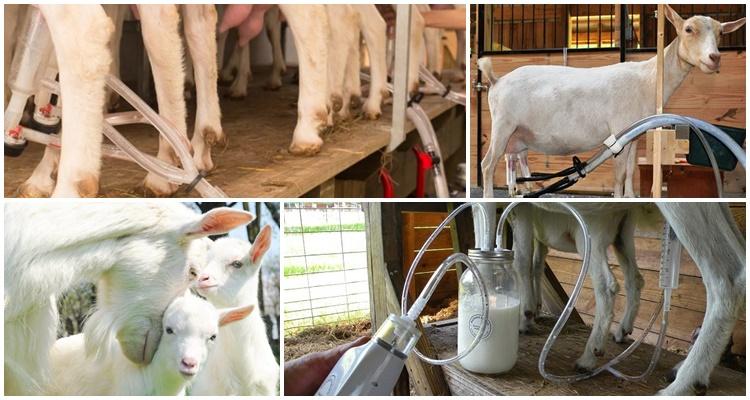
Frequency
Milking frequency is determined by various factors. For example, the season: in the summer goats are milked three times a day, and in the winter - twice. After lambing, the animals are milked 4-5 times, and strictly according to the regimen. This increases the productivity of the goat by 20%, as the body of the animals gets used to the schedule and often stimulates lactation itself. On the 8-9th day, the number of milkings is reduced to 3 times, after a month it is increased to two times.
The number of milkings also depends on the amount of milk being milked. If milk is less than 2.5 liters per day, then you can get by with two milkings. If more, then it is advisable to milk 3-4 times a day.
Usually, farmers adhere to the initial four-, five-time regimen for almost 3 months after the birth of offspring. But still, the most favorable regime after the transition of the kids to adult nutrition is considered to be three milkings a day.
Goat milk is preferable to most other types because of its high taste and healing qualities, and its inexpensive content and unpretentiousness only increase the love for it. Real goat cheese is especially appreciated by consumers. Despite the fact that many are afraid of the milking process, there is nothing difficult about it. Even a novice farmer can master it, if you follow the advice of experienced livestock breeders and treat your animals with love.
